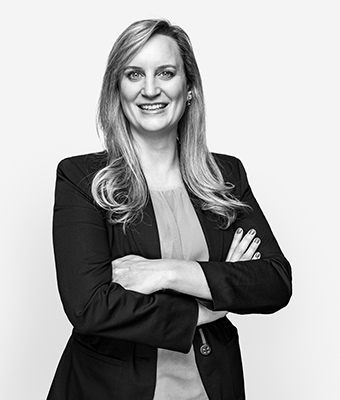»Techies love solving problems«
Contribution to SDGs
This story is an example of Clariant’s contribution to SDG 8 and SDG 9. Read more in Sustainable Development Goals
-
Promote sustained, inclusive and sustainable economic growth, full and productive employment and decent work for all
-
Build resilient infrastructure, promote inclusive and sustainable industrialization and foster innovation
Kimberley McCall talks about her work as Clariant’s first Digital & IT Talent Acquisition Specialist and why new job profiles call for new ways of recruiting.
Kimberley, your job is recruiting tech talent. What are the profiles that Clariant looks for?
The chemical industry as a whole has championed automation and the use of digital equipment since very early on. But when it comes to new digital business models and leveraging big data or even artificial intelligence, we still have a way to go. And those areas are where we at Clariant are now looking for new kinds of tech talent. Data scientists, full-stack software developers, and user experience (UX) designers are just some of the job profiles a typical chemical company would not have had that much use for ten or even five years ago. Not to mention the need for even more complex »hybrid« profiles, which require a combination of tech and specific business acumen.
Why do these profiles need a specific recruiter like yourself?
Make no mistake, when I joined a little less than two years ago, my colleagues in Talent Acquisition were already hiring these specialists. But with so many new and highly specific profiles, there was a need for someone to really dive deep and learn exactly what we need and where to find it.
How did you learn that?
I did a lot of reading and googling at first. But more importantly, I went out to conferences, expos, and other events to meet people and talk to them about what they do and why.

»It takes time to build a network and create a name for yourself.«
Kimberley McCall Digital & IT Talent Acquisition Specialist
Is the »why« important?
Absolutely. What motivates techies was one of the key things for me to understand. I learned that they generally have a few things in common: they love solving problems, the more challenging and meaningful, the better. They share a need to have a positive impact. They want the ability to make decisions and implement changes effectively and efficiently. These key insights help me highlight why Clariant and its digital start-ups are such interesting places to work.
You joined Clariant less than two years ago yourself. What drew you to the company?
I have spent most of my professional life in the chemical industry and have always appreciated the opportunities and positive challenges I was given, even though I don’t have a science background. I moved into recruiting a couple of years before joining Clariant. Some of that work was as a consultant in London for a range of industries. There, I gathered invaluable experience working in a fast-paced, competitive agency environment, but realized that I would, at some point, want to continue my work internally. It would allow me to deep dive into a specific company to make sense of its intricacies and stay connected and closely follow the progress of those I had helped hire. So when Clariant offered me the opportunity to recruit for them and to actually help establish a new approach to their tech hiring process, that really appealed to me.
What’s your role today?
I’m responsible for digital & IT recruitment for Clariant and all vacancies related to our digital start-ups, most notably Chemberry™ and Navigance™. I play a consultative role for Business Units and departments that are looking to hire people with tech-related skill sets or to staff upcoming digital ventures.
Corporate learning
What to teach and how

Kirsten Neumann
Head of Center of Excellence »Learning & Academy«
Clariant’s corporate learning strategy is reshaping how the company trains and develops professionals.
Technology is transforming the workplace. With digitalization seeping into more and more jobs, there is a growing need for what some are calling hybrid skill sets. From marketing managers who work with chatbots to chemists who delve into big data – Clariant increasingly needs people who can straddle those fading lines between different domains. »Some of these very specific skill combinations are almost impossible to find on the market. That’s why systematically up-skilling the experts you have makes a lot of business sense,« says Kirsten Neumann, Head of Clariant’s Center of Excellence »Learning & Academy.« That is one reason why Clariant recently reshaped its corporate learning strategy. One of its pillars is to provide best-in-class learning formats.
Neumann and her team, who are all consultants for personal development and instructional designers, use their knowledge to tailor every course to fit Clariant’s needs. That starts with first going out to all businesses and actually asking what a department or team wants to achieve in the short and medium term. »A nice side effect of involving supervisors this way is that it makes them more likely to later encourage our participants to actually apply what they have learned,« says Neumann.
Neumann also found that every course benefits from incorporating interactive or even playful exercises, preferably based on a practical case study. Another rule is to keep those courses short and focused on the defined key competencies. That’s in keeping with Clariant’s special emphasis on what’s called social learning: »We set up learning communities where the participants meet in moderated classes and share their experiences – both good and bad – with applying new skills in their day-to-day work,« Neumann explains. »That helps a lot more than any formal training ever would.« Additional virtual briefings both before and after each training session provide for a better preparation, help to transfer knowledge, and encourage the group to connect with their new network across regions.
Unsurprisingly, Clariant aims to increase the impact of each and every training. To monitor this, Neumann and her team survey participants and their supervisors after a few months. One thing they ask is how much of the curriculum participants were actually able to apply. »And we’re already getting really good scores here, which tells us we’re on the right track,« says Neumann.
Another shift involves the Clariant Academy, the company’s global framework for courses mainly on leadership, personal development, and change. »While most of our courses are still face-to-face, we are moving into online learning and also test what recognized business schools can offer here,« says Neumann. »And we are incorporating more offerings on, for example, virtual leadership and online collaboration as well as self-directed learning elements, such as peer coaching groups. All of these can be conducted remotely.«
Additionally, Clariant is running a pilot for its IT department on LinkedIn Learning. The popular online platform features a vast library of technical and business training courses, mostly in the form of online instructional videos. »If you look at IT, it’s not just about new technology, but also about business acumen and new ways of collaborating – agile work, Scrum, working in sprints, and so on,« Neumann explains.
For Clariant as a company, using new ways of learning has become crucial to achieving its business goals. And for everyone individually, it helps to grow further, to stay motivated, and to ensure lifelong employability. While digitalization may put pressure on people and businesses to change, it also offers new ways to do so.
Where do you find a data scientist or a software developer?
You mostly find them where these skills are taught, developed, and engaged, so in university towns and technology hotspots. Then, it’s a question of identifying and engaging the most suitable candidates for our vacancies. It takes time to build a network and create a name for yourself, which is what I’ve been doing for almost two years now by attending after-work events and meet-ups. And it will remain a crucial element for continued success. Referrals and suggestions from current Clariant employees are also a highly valuable source for suitable applicants.
With whom does Clariant compete for this kind of tech talent?
The skills these specialists have and the tools they employ are applicable in a wide range of industries. So we’re naturally competing with a lot more companies and organizations than we would, say, for a chemist.
And everybody wants to work for well-known tech giants…
Not necessarily! People are generally motivated in different ways and will pursue the employer that they feel will help them fulfill their individual needs and aspirations. I would, however, dare to say that somebody who really dreams of working for the known tech giants would likely not thrive in our work environment.
How so?
Working for one of those data giants has its allure and its perks. But these companies employ hundreds, if not thousands, of tech specialists, and for some, this may seem as though they are a small fish in a big pond. When you join a company that is still building up its data and tech acumen, I’d argue that you get a lot more in terms of exposure, responsibility, and creative freedom.
Are you yourself using tech to recruit people?
Yes. We work closely with Clariant’s Employer Branding to make use of digital channels a lot more professionally. We’re also interviewing people via video chat. That helps a lot. Candidates may be based anywhere in the world and they simply expect that sort of flexibility from an employer. It is also a great way of getting candidates in touch with our tech experts on the inside early on. That’s something that works extremely well. It’s important for digital talent to see that their employer understands what they do, speaks their language, and offers interesting projects.
How do you »sell« Clariant to a prospective hire?
I don’t. Or rather, I don’t try to portray Clariant as anything different than what it is. I don’t believe that would be a sustainable way of engaging employees. I let the facts speak for themselves. We offer interesting and diverse greenfield projects and provide a space to develop ideas and create a significant impact – in addition to other great perks. But although we have a good value proposition as an employer and strive for continuous improvement, there are areas where we could do even better.
Where do you see a need for Clariant to improve?
This is a rapidly changing world, and we need to continue to adapt to maintain our strong position in the market. Corporate culture, flexible work models, incentive options, innovation, and the utilization of the newest technologies as well as a positive social impact are key to both attracting and retaining our tech workforce. We are working on these things, but there’s still a way to go.
Do you notice a difference between recruiting for Clariant’s core business and for its digital start-ups?
Yes, recruiting for a start-up is different than recruiting for a big corporation. The good thing about us is that we offer the best of both worlds and can leverage our synergies. The different sides of the business have very different pros and cons, so they attract applicants with varied needs and motivations. There are those that thrive in a less developed working environment with all its uncertainties, and then there are those that value the more established structures of a big corporation. At the end of the day, it all comes down to establishing the best possible fit at the right point in time.